Wednesday, October 28th 2020

AMD Announces the Radeon RX 6000 Series: Performance that Restores Competitiveness
AMD (NASDAQ: AMD) today unveiled the AMD Radeon RX 6000 Series graphics cards, delivering powerhouse performance, incredibly life-like visuals, and must-have features that set a new standard for enthusiast-class PC gaming experiences. Representing the forefront of extreme engineering and design, the highly anticipated AMD Radeon RX 6000 Series includes the AMD Radeon RX 6800 and Radeon RX 6800 XT graphics cards, as well as the new flagship Radeon RX 6900 XT - the fastest AMD gaming graphics card ever developed.
AMD Radeon RX 6000 Series graphics cards are built upon groundbreaking AMD RDNA 2 gaming architecture, a new foundation for next-generation consoles, PCs, laptops and mobile devices, designed to deliver the optimal combination of performance and power efficiency. AMD RDNA 2 gaming architecture provides up to 2X higher performance in select titles with the AMD Radeon RX 6900 XT graphics card compared to the AMD Radeon RX 5700 XT graphics card built on AMD RDNA architecture, and up to 54 percent more performance-per-watt when comparing the AMD Radeon RX 6800 XT graphics card to the AMD Radeon RX 5700 XT graphics card using the same 7 nm process technology.AMD RDNA 2 offers a number of innovations, including applying advanced power saving techniques to high-performance compute units to improve energy efficiency by up to 30 percent per cycle per compute unit, and leveraging high-speed design methodologies to provide up to a 30 percent frequency boost at the same power level. It also includes new AMD Infinity Cache technology that offers up to 2.4X greater bandwidth-per-watt compared to GDDR6-only AMD RDNA -based architectural designs.
"Today's announcement is the culmination of years of R&D focused on bringing the best of AMD Radeon graphics to the enthusiast and ultra-enthusiast gaming markets, and represents a major evolution in PC gaming," said Scott Herkelman, corporate vice president and general manager, Graphics Business Unit at AMD. "The new AMD Radeon RX 6800, RX 6800 XT and RX 6900 XT graphics cards deliver world class 4K and 1440p performance in major AAA titles, new levels of immersion with breathtaking life-like visuals, and must-have features that provide the ultimate gaming experiences. I can't wait for gamers to get these incredible new graphics cards in their hands."
Powerhouse Performance, Vivid Visuals & Incredible Gaming Experiences
AMD Radeon RX 6000 Series graphics cards support high-bandwidth PCIe 4.0 technology and feature 16 GB of GDDR6 memory to power the most demanding 4K workloads today and in the future. Key features and capabilities include:
Powerhouse Performance
In the coming weeks, AMD will release a series of videos from its ISV partners showcasing the incredible gaming experiences enabled by AMD Radeon RX 6000 Series graphics cards in some of this year's most anticipated games. These videos can be viewed on the AMD website.
AMD Radeon RX 6000 Series graphics cards are built upon groundbreaking AMD RDNA 2 gaming architecture, a new foundation for next-generation consoles, PCs, laptops and mobile devices, designed to deliver the optimal combination of performance and power efficiency. AMD RDNA 2 gaming architecture provides up to 2X higher performance in select titles with the AMD Radeon RX 6900 XT graphics card compared to the AMD Radeon RX 5700 XT graphics card built on AMD RDNA architecture, and up to 54 percent more performance-per-watt when comparing the AMD Radeon RX 6800 XT graphics card to the AMD Radeon RX 5700 XT graphics card using the same 7 nm process technology.AMD RDNA 2 offers a number of innovations, including applying advanced power saving techniques to high-performance compute units to improve energy efficiency by up to 30 percent per cycle per compute unit, and leveraging high-speed design methodologies to provide up to a 30 percent frequency boost at the same power level. It also includes new AMD Infinity Cache technology that offers up to 2.4X greater bandwidth-per-watt compared to GDDR6-only AMD RDNA -based architectural designs.
"Today's announcement is the culmination of years of R&D focused on bringing the best of AMD Radeon graphics to the enthusiast and ultra-enthusiast gaming markets, and represents a major evolution in PC gaming," said Scott Herkelman, corporate vice president and general manager, Graphics Business Unit at AMD. "The new AMD Radeon RX 6800, RX 6800 XT and RX 6900 XT graphics cards deliver world class 4K and 1440p performance in major AAA titles, new levels of immersion with breathtaking life-like visuals, and must-have features that provide the ultimate gaming experiences. I can't wait for gamers to get these incredible new graphics cards in their hands."
Powerhouse Performance, Vivid Visuals & Incredible Gaming Experiences
AMD Radeon RX 6000 Series graphics cards support high-bandwidth PCIe 4.0 technology and feature 16 GB of GDDR6 memory to power the most demanding 4K workloads today and in the future. Key features and capabilities include:
Powerhouse Performance
- AMD Infinity Cache - A high-performance, last-level data cache suitable for 4K and 1440p gaming with the highest level of detail enabled. 128 MB of on-die cache dramatically reduces latency and power consumption, delivering higher overall gaming performance than traditional architectural designs.
- AMD Smart Access Memory - An exclusive feature of systems with AMD Ryzen 5000 Series processors, AMD B550 and X570 motherboards and Radeon RX 6000 Series graphics cards. It gives AMD Ryzen processors greater access to the high-speed GDDR6 graphics memory, accelerating CPU processing and providing up to a 13-percent performance increase on a AMD Radeon RX 6800 XT graphics card in Forza Horizon 4 at 4K when combined with the new Rage Mode one-click overclocking setting.9,10
- Built for Standard Chassis - With a length of 267 mm and 2x8 standard 8-pin power connectors, and designed to operate with existing enthusiast-class 650 W-750 W power supplies, gamers can easily upgrade their existing large to small form factor PCs without additional cost.
- DirectX 12 Ultimate Support - Provides a powerful blend of raytracing, compute, and rasterized effects, such as DirectX Raytracing (DXR) and Variable Rate Shading, to elevate games to a new level of realism.
- DirectX Raytracing (DXR) - Adding a high performance, fixed-function Ray Accelerator engine to each compute unit, AMD RDNA 2-based graphics cards are optimized to deliver real-time lighting, shadow and reflection realism with DXR. When paired with AMD FidelityFX, which enables hybrid rendering, developers can combine rasterized and ray-traced effects to ensure an optimal combination of image quality and performance.
- AMD FidelityFX - An open-source toolkit for game developers available on AMD GPUOpen. It features a collection of lighting, shadow and reflection effects that make it easier for developers to add high-quality post-process effects that make games look beautiful while offering the optimal balance of visual fidelity and performance.
- Variable Rate Shading (VRS) - Dynamically reduces the shading rate for different areas of a frame that do not require a high level of visual detail, delivering higher levels of overall performance with little to no perceptible change in image quality.
- Microsoft DirectStorage Support - Future support for the DirectStorage API enables lightning-fast load times and high-quality textures by eliminating storage API-related bottlenecks and limiting CPU involvement.
- Radeon Software Performance Tuning Presets - Simple one-click presets in Radeon Software help gamers easily extract the most from their graphics card. The presets include the new Rage Mode stable over clocking setting that takes advantage of extra available headroom to deliver higher gaming performance.
- Radeon Anti-Lag - Significantly decreases input-to-display response times and offers a competitive edge in gameplay.
In the coming weeks, AMD will release a series of videos from its ISV partners showcasing the incredible gaming experiences enabled by AMD Radeon RX 6000 Series graphics cards in some of this year's most anticipated games. These videos can be viewed on the AMD website.
- DIRT 5 - October 29
- Godfall - November 2
- World of Warcraft : Shadowlands - November 10
- RiftBreaker - November 12
- FarCry 6 - November 17
- AMD Radeon RX 6800 and Radeon RX 6800 XT graphics cards are expected to be available from global etailers/retailers and on AMD.com beginning November 18, 2020, for $579 USD SEP and $649 USD SEP, respectively. The AMD Radeon RX 6900 XT is expected to be available December 8, 2020, for $999 USD SEP.
- AMD Radeon RX 6800 and RX 6800 XT graphics cards are also expected to be available from AMD board partners, including ASRock, ASUS, Gigabyte, MSI, PowerColor, SAPPHIRE and XFX, beginning in November 2020.
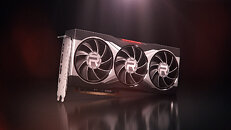
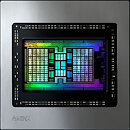
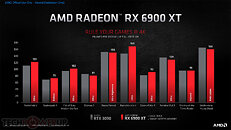
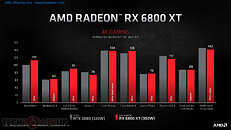
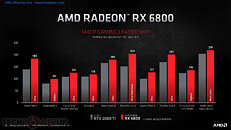
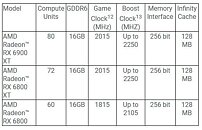
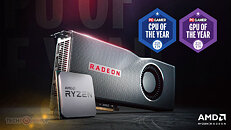
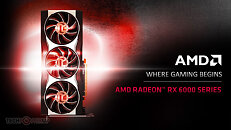
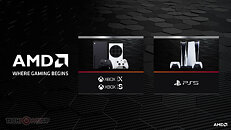
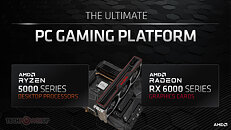
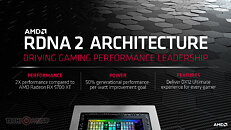
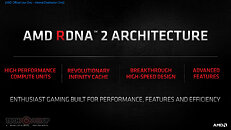
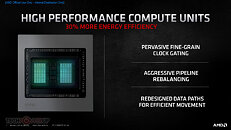
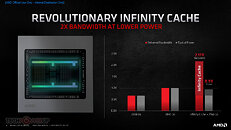
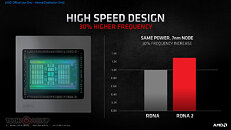
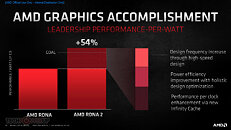
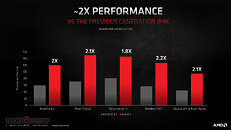
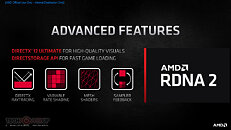
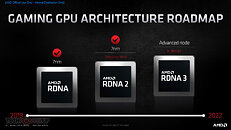
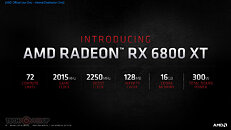
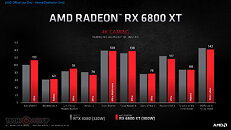
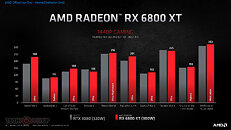
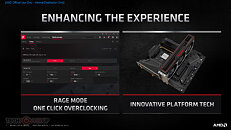
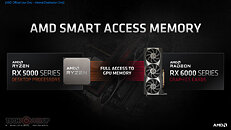
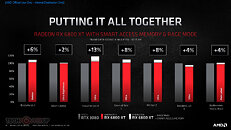
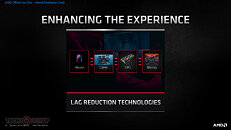
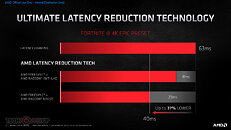
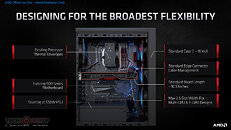
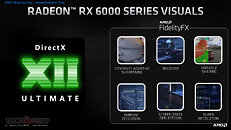


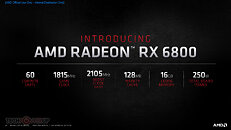
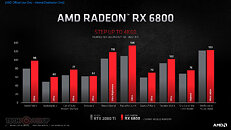
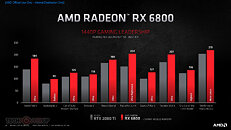
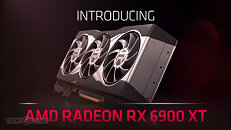
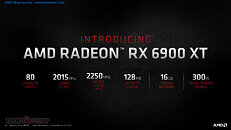
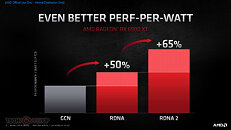
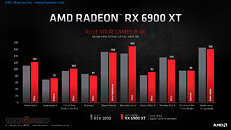
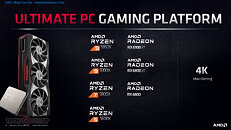
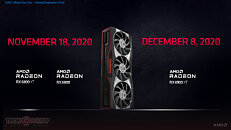
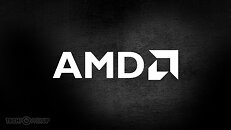
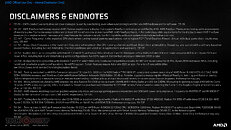
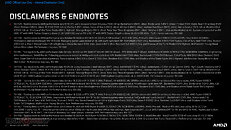
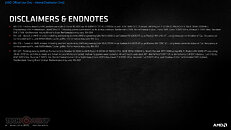
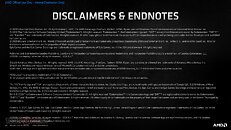
394 Comments on AMD Announces the Radeon RX 6000 Series: Performance that Restores Competitiveness
Or just not use rage mode. Cant get a proper idea of performance, although they "are" just slides.
Need a proper game-off between these two cards
Unless there's a card with substantially superior performance (VS my current card) @ a LOW power consumption that costs @ most 380€, i'll be skipping this round of GPUs entirely.
But at $50 less for more +5 GB VRAM (albeit standard GDDR6 with an extra 128 MB Infinity Cache) kind of evens that out in a way. From a performance perspective, based off AMD's slides, they are nearly match-for-match, which is what we as consumers need.The current RTX 2060 Super, RX 5700 XT and RTX 2070 looks like that would fulfill that for you, unless you want the newer architectures for upcoming games.
The cheapest available 5700 XT costs 390€, and that's with a 35€ discount promotion. In any case, it's power consumption is WAY too high for me.
As for nVidia's offerings, i dislike their business practices so i avoid their cards entirely: i "speak" with my wallet.
118/75 is 57 percent faster for less than 57 percent more money. So you're just wrong, sorry.
But lower Rt performance
and that price is ridiculously high
I think that infinity cache think takes a lot of Resources,Maybe I'm wrong
The price of the 6800XT does not look that bad to me, AMD should be able to charge just as much as nvidia at this point.(given similar performance) This is why I suspect the 6900XT is cheaper and nothing is wrong with that, they know its not as fast as the 3090 without rage mode and price accordingly. The RX 5700XT drivers were better than the RX 480 and 580 drivers were, its a moot point to say AMD's drivers suck now and I know they're not perfect but they're not as bad as what people say.
Competition is always good for us though, where you at intel.
If it was better performance for the same price, then you would have a winner and that is usually the case with AMD
docs.google.com/spreadsheets/d/e/2PACX-1vRiUs-djAp9gFiFjGM1S_GTZ7CH1nrDV9GWlTsHWOnvaYLfQoKyBPeLX75qVLrkFuizf8QR6gu8gkgU/pubhtml?gid=0&single=true
I don't care about 4k or all the other ways in which nVidia misleads people, I want actual in game fps to increase at 1440p. If that is what AMD delivers (and it looks like their 1440p numbers are incredible) it is a slam dunk. Even the base 6800 might be VERY close to the 3080, yet $120 cheaper (actually $220 cheaper since the FE was never for sale), and with 6GB more VRAM. At 1440p there might only be a 5 percent difference. We'll see.
I'm doing the same with this RTX 3080. At only 887 mV it keeps the TBP (according to GPU-Z) at 270W but it still boosts to 1950 MHz which is more than enough for 3440x1440 at 144 Hz. Not to mention staying cool on load at 65C.
www.amd.com/en/products/specifications/compare/graphics/10516%2C10521%2C10526
Just look at the last decade: $349 GTX 570 vs $369 HD 6970, R9 280X $299 GPU competing with $399 USD GTX 770, GTX 970 was $329, Vega 56 $399 beating great 1070 $379 AND then came infamous Turing RTX 2070 first $499 GPU. AMD fought against price hike with $349 RX 5700 but already tried to squeeze 399 out of it on release conference. Fast forward to today and people are praising Nvidia for not price hiking xx70 class GPU again while we get price hike to $579 from AMD and ppl praise it as a good deal because it offer 8 gigs more vram (costing amd additional 50 bucks in worse case scenario). Where's the value in that? Such price hikes would get obliterated by tech media just 7 years ago and now it's OK? I mean, what's wrong with us?
On price, I'd like the RX 6800 to be less (sure), but for like $40 they're doubling the memory, so that's good. While the RX 6800 XT provides that additional 6b, the RTX3080 is the GDDR6X on 320-Bus offering like 50% bandwidth. The RX 6800 XT might about right or slightly high depending on reviews, although besting the RTX 2080 Ti for 32% less and sure 2 years later. I'm good with it. Finally, near RTX 3090 performance for 50% less cost, no one should be crying... you should expect a bloody nose if you want to play in that neighborhood.
My graph? Uh... No. I didn't make that graph.
You do know where that graph's from, right?
Ah wait, I think I know what you're saying.
That graph they posted with SAM. Yeah, we don't have Zen3 CPUs to compare to yet. Unlike the 6800XT which was an apples-to-apples comparison, the 6800 graph isn't a fair comparison and is using the Zen3 + Infinity Cache + SAM amalgamated results to make it look better. Some of those results are pretty impressive but they're deliberately unfair to promote the whole 3-part solution of Ryzen5000+X570+RX6800. We won't know until November what the actual GPU-only results are, and I was just going off Lisa Su's actual words when she said "matches a 2080Ti at just $579"
EDIT: Review UPP first before you use the GUI above